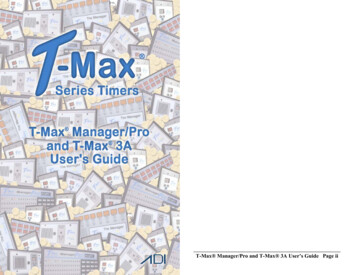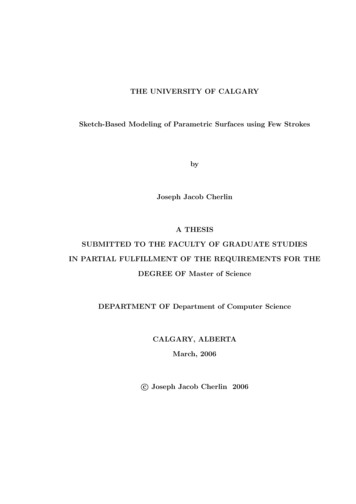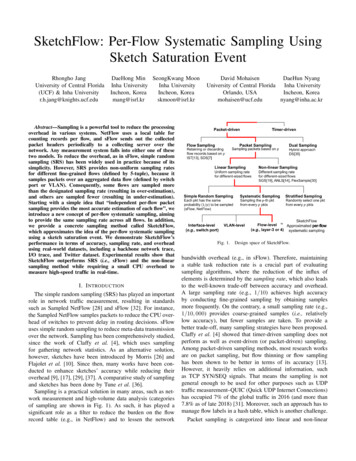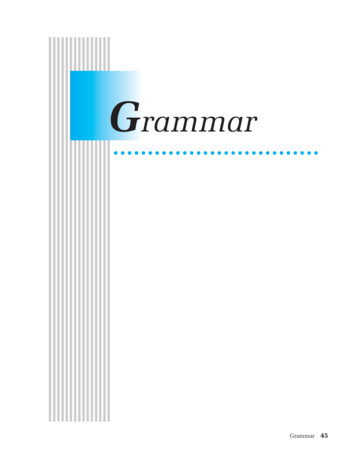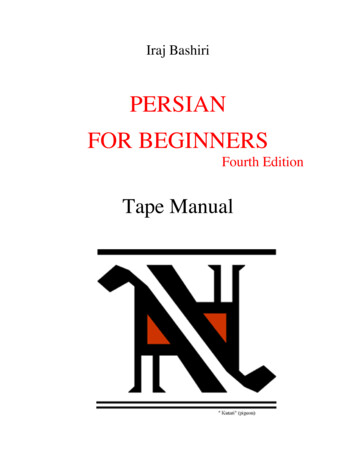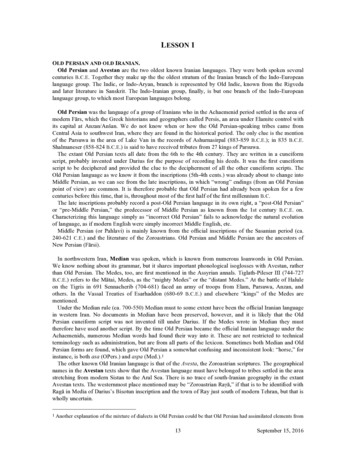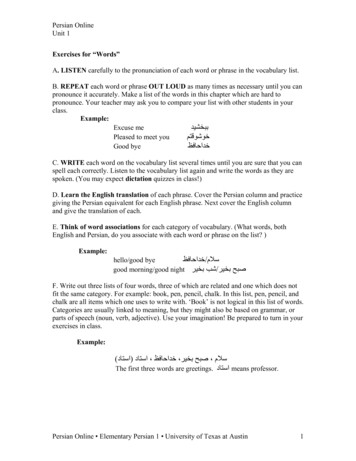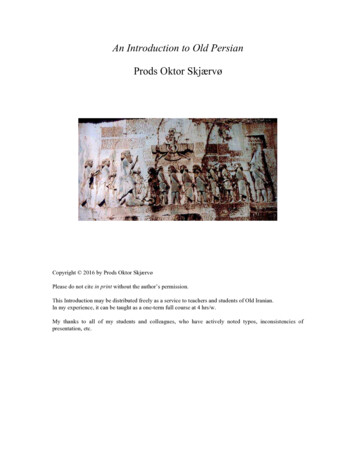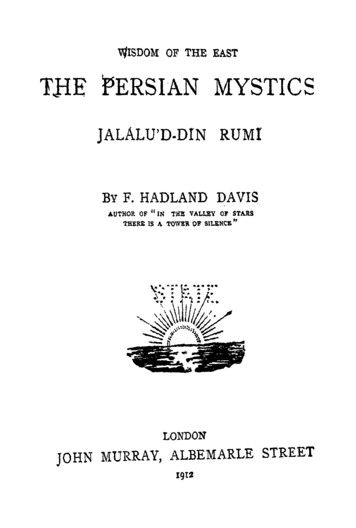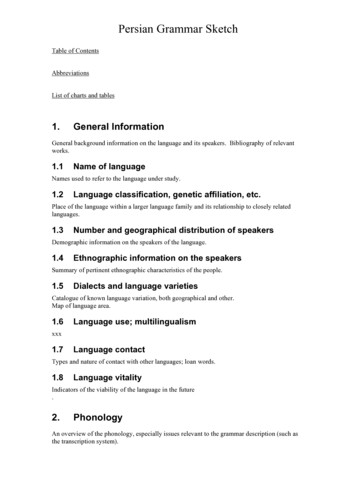
Transcription
Persian Grammar SketchTable of ContentsAbbreviationsList of charts and tables1.General InformationGeneral background information on the language and its speakers. Bibliography of relevantworks.1.1Name of languageNames used to refer to the language under study.1.2Language classification, genetic affiliation, etc.Place of the language within a larger language family and its relationship to closely relatedlanguages.1.3Number and geographical distribution of speakersDemographic information on the speakers of the language.1.4Ethnographic information on the speakersSummary of pertinent ethnographic characteristics of the people.1.5Dialects and language varietiesCatalogue of known language variation, both geographical and other.Map of language area.1.6Language use; multilingualismxxx1.7Language contactTypes and nature of contact with other languages; loan words.1.8Language vitalityIndicators of the viability of the language in the future.2.PhonologyAn overview of the phonology, especially issues relevant to the grammar description (such asthe transcription system).
2Persian Grammar SketchNote: Erik Anonby’s phonology of Lur-Mamasani begins with syllable structure and alsoincludes the analysis of ambiguous segments and the reasons for one analysis over another.This would be a good model to follow for a more complete phonological description.2.1Phonological unitsSummary information on the phonological segments of the language, phoneme chartMay be useful ****STEM NUMBER SUFFIX DIMINUTIVE SUFFIX 2.1.1 Distinctive segments2.1.2 Phonetic 2.2PhonotacticsSummary of the most notable allophonic processes found throughout the phonological system.2.2.1 Distribution of nonsyllabic segments2.2.1.1Word-final consonants2.2.1.2Word-initial consonants2.2.1.3Consonant clusters2.2.1.4Description of consonant clusters2.2.2 Admissable vowels2.2.2.1Word-final vowelsPERSIAN GRAMMAR SKETCH.DOC22-Aug-05
Persian Grammar Sketch2.2.2.2Word-initial vowels2.2.2.3Sequences of vowels32.2.3 Structure of lexical morphemes2.2.4 Syllable structure2.2.4.1Consonant clusters and syllables2.2.5 Co-occurrence restrictions2.2.5.1Word/syllable initial elements2.2.5.2Word/syllable-final elements2.2.5.3Initial-final restrictions2.2.5.4Vowel harmony2.2.5.5Consonant harmony2.2.5.6Restrictions between adjacent or nonadjacent segments2.2.5.7Phonotactic patterns with different word classes2.3Suprasegmental features2.3.1Length distinctionPERSIAN GRAMMAR SKETCH.DOC22-Aug-05
4Persian Grammar Sketch2.3.1.1Vowel length2.3.1.2Length in other syllables2.3.1.3Length in glides/semivowels2.3.1.4Length in liquids2.3.1.5Length in nasals2.3.1.6Length in fricatives2.3.1.7Length in plosives2.3.2 Stress2.3.2.1Role of stress2.3.2.2Phonetic correlates of stress2.3.2.3Levels of stress2.3.2.4Position of stress2.3.2.5Predictability of stress2.3.3 Intonation2.3.3.1Major intonation patterns2.3.3.2Intonation peakPERSIAN GRAMMAR SKETCH.DOC22-Aug-05
Persian Grammar Sketch2.3.3.3Emphatic intonation2.3.3.4Contrastive stress2.3.3.5Subtypes of intonation patterns2.3.3.6Interaction of intonation patterns with tone height2.45Morphophonological processes (segmental)2.4.1 Morphophonology2.4.1.1Assimilatory processes2.4.1.2Dissimilation2.4.1.3Other alternations between segments2.4.2 Metathesis2.4.3 Coalescense and split2.4.4 Deletion and insertion2.4.4.1Deletion processes2.4.4.2Insertion processes2.4.5 ReduplicationPERSIAN GRAMMAR SKETCH.DOC22-Aug-05
6Persian Grammar Sketch2.4.6 Other process2.4.6.1Geminate simplification2.4.6.2Deaspiration2.5Suprasegmental morphophonologicaly2.5.1 Stress and morphological processes and compounding2.5.2 Stress and phonological structure2.6Orthographic conventionsA general description of the basic principles of the orthography, Explanation of thetranscriptions used in the data.The Farsi orthography is over-representative with regard to consonants and underrepresentative with regard to vowels.Table 2.1: Persian ConsonantsIPASymbol[β][ πΗ ][τΗ][σ][δ Ζ ]Isolated ﺏ ﭖ ﺕ ﺙ ﺝ FinaljoinedMedial ﺏ ﭖ ﺕ ﺙ ﺝ [ξ ][δ ] [ τΣ][η]Initial ﺡ ﺥ ﺩ ﺡ ﺥ ﺩ PERSIAN GRAMMAR SKETCH.DOC NamesRomanSymbolbebpeptetse *sjimjčimčhejimihxexdāld22-Aug-05
Persian Grammar Sketch[ζ ][ρ][ζ ][Ζ][σ][Σ][σ][ζ ][τΗ][ζ ] ﺫ ﺭ ﺯ ﮊ ﺱ ﺵ ﺹ ﺽ ﻁ ﻅ 7 ﺫ ﺭ ﺯ ﮊ ﺱ ﺵ ﺹ ﺽ ﻁ ﻅ zāl *z rerzezğeğ sins šinš sād *s zād *ztā *tzā *zein *’qein *qfefqāfqkāfkgāfg lāml mimm nunnvevhedočešmhyey [?] ء [θ][φ] ﻑ ﻑ [θ][ κΗ ][γ ][λ][µ ][ν][ϖ][η][ϕ] ﮎ ﮒ ﻝ ﻡ ﻥ ﻭ ﻩ ﯼ ﮎ ﮒ ﻝ ﻡ ﻥ ﻭ ﻪ ﯼ NOTE: The Farsi letters marked with * occur mainly in words borrowed from Arabic.PERSIAN GRAMMAR SKETCH.DOC22-Aug-05
8Persian Grammar SketchSome examples of words with different letters that have the same sound.tetā * ﺕ ﺕﺍﺭﻱﺥ ﻁ ﻁﺭﻑ tārix‘date’taraf‘side’se *sinsād * ﺙ ﺱ ﺹ ﺙﺍﻥﯼ ﺱﻑﺭ ﺹﻑﺭ āl *zezād *zā * ﺫ ﺫﻩﻥ ﺯ ﺯﻭﺩ ﺽ ﺽﻉﻑ ﻅ ﻅﻩﺭ hr‘noon’hejimihedocheshmqein *qāf ﺡ ﺡﺭﻑ ﻩ ﻩﺭ harf‘word’har‘every’ ﻍﺭﺏ ﻕﺭﺍﺭ qarb‘west’qarār‘arrangement’Table 2.2: Persian VowelsIPASymbol[α][υ ][ι][Θ][Ε][ ][ ϕ]Isolate ﺍ ﻭ ﯼ ﻩ ﻩ ﻭ ﯼﺍ FinaljoinedMedialInitial ﺍ ﺁ ﺍﻭ ﺍ َ ﺍ ِ ﺍ ُ ﺍ ﺁ ﺍ ﻭ ﯼ ﻪ ﻪ ﻭ ﯼﺍ PERSIAN GRAMMAR SKETCH.DOC ﻭ َُِ ﺍ NamesRomanSymbolalefāuiaeoai22-Aug-05
Persian Grammar Sketch[εϕ]ِ ﯼ ُﻭ ﯼﻭ ﯼﻭ [ οω ][ ι][υ ϕ ]9ِ ﯼ ُﻭ ﯼﻭ ﯼﻭ ِ ُﻭ ﻭ ﻭ eiِ ﺍ ﺍُ ﻭ ُ ﺍ ﺍﻭ ouoiuiVowels ā, u and i are long. Vowels a, e and o are short. In addition to their roles as consonants ﻩ ﻱ the letters, , andare used to represent vowels. But they are only used to fullyrepresent the long vowels, as indicated in the chart. The short vowels are represented in word ﺍ initial position by the alef symbol and a diacritic, and in word medial position just by adiacritic. However, these diacritics are usually left out in the printed form.Table 2.3: Vowel Initial WordsWith Diacritics ﺁﺏ ﺁﺱﻡ ﺍﻭﻥ ﺍﻱﻥ ﺍَﺱﺏ ﺍِﺱﻡ ﺍُﻡﻱﺩ Without Diacritics ﺁﺏ ﺁﺱﻡ ﺍﻭﻥ ﺍﻱﻥ ﺍﺱﺏ ﺍﺱﻡ ﺍﻡﻱﺩ TransliterationEnglish n‘this’asb (esb, osb)‘horse’esm (asm, osm)‘name’omid (amid, emid)‘hope’TransliterationEnglish Meaningbe‘to, in’bah‘wow’na‘no’noh‘nine’Table 2.4: Vowel Final WordsWith DiacriticsWithout Diacritics ﺏﻩ ﺏﻩ ﺏَﻩ ﺏﻩ ﻥﻩ ﻥﻩ ﻥُﻩ ﻥﻩ PERSIAN GRAMMAR SKETCH.DOC22-Aug-05
10Persian Grammar SketchTable 2.5: Glottal Initial WordsWith DiacriticsWithout Diacritics ءﺍﻝﻱ ءﻭﻥ ءﻱﺏ ءَﺹﺭ ءَﻝﻡ ءِﻝﻡ ءُﺯﺭ ءُﻡﺭ ءَﻡﺭﺍﻥ ءُﻡﺭﺍﻥ 3.Morphology3.1Morphemes ءﺍﻝﻱ ءﻭﻥ ءﻱﺏ ءﺹﺭ ءﻝﻡ ءﻝﻡ ءﺯﺭ ءﻡﺭ ءﻡﺭﺍﻥ ءﻡﺭﺍﻥ TransliterationEnglish ��asr‘late rgiveness’omr‘life, age’amrān‘father of Moses’omrān‘improvement’Describe the types of stems and roots that form the base of words, and whether they are boundor free. Say which are the open and closed classes of stems.3.2AffixationDescribe the different types of affixation, e.g. linear: prefixation and suffixation, nonlinear:infixation, mutation, reduplication, suprafixation, etc. Say which of the following means areused to express syntactic and semantic functions: bound affixes, morphophonemic alternationsalone (internal change), clitic particles, pre-/postpositions, derivational processes, other means specify.3.3AllomorphyDescribe the instances of allomorphy where the same morpheme is represented by differentallomorphs, e.g. in English the ‘past tense’ is represented by the allomorphs /ɪd/, /d/ and /t/. Saywhether the allomorphy is phonologically conditioned or lexically conditioned.PERSIAN GRAMMAR SKETCH.DOC22-Aug-05
Persian Grammar Sketch3.411SyncretismDescribe the instances of syncretism where different grammatical words are represented by thesame word-form, e.g. in English the word boiled can be a verb, a past participle, a passiveparticiple or a deverbal adjective.3.5Portmanteau morphemesDescribe the instances of portmanteau morphology where a single morph simultaneouslyrepresents multiple grammatical categories. For example, in Spanish the verb suffix -ssimultaneously represents the categories of person, number and present tense.3.6Suppletion and fusionDescribe the instances where a lexical meaning and a grammatical meaning are represented bya single indivisible form. For example, in English many of the past tense forms of verbs havesuppletive stems, e.g. grow and grew.3.7Derivational morphologyWhat possibilities exist for deriving members of one category from those of the same oranother category? For each pair of categories, indicate the formal means of derivation, and theirsemantic correlates. Are any of these processes iterative (e.g. double diminutive, causative ofcausative)? Indicate the degree of productivity of each process, and of its semantic regularity.3.7.1 Derivation of nounsDescribe the different types of noun derivation.nouns from nounsnouns from verbsTo what extent is the syntax of deverbal nouns similar to that of a sentence, and to what extentlike that of a nonderived noun?nouns from adjectivesTo what extent is the syntax of deadjectival nouns similar to that of a sentence, and to whatextent like that of a nonderived noun?nouns from adverbsnouns from any other category3.7.2 Derivation of verbsDescribe the different types of verb derivation.verbs from nounsverbs from verbs (see also the section on voice, 2.1.3.1 )verbs from adjectivesverbs from adverbsverbs from any other category3.7.3 Derivation of adjectivesDescribe the different types of adjective derivation.adjectives from nounsadjectives from verbsadjectives from adjectivesadjectives from adverbsadjectives from any other categoryPERSIAN GRAMMAR SKETCH.DOC22-Aug-05
12Persian Grammar Sketch3.7.4 Derivation of adverbsDescribe the different types of adverb derivation.adverbs from nounsadverbs from verbsadverbs from adjectivesadverbs from adverbsadverbs from any other category3.7.5 Other possible derivationsDescribe the possibilities for forming complex pre-/postpositions.Two prepositions (distinguish genuine compound prepositions of the type on to from sequencesresulting from cases where a preposition has as its argument a prepositional phrase, e.g. frombehind. In English these can for example be distinguished by means of the modification, e.g.from ten yards behind the car, *on ten yards to the table)nominal formations, e.g. in front ofverbal formations, e.g. depending onadjectival formationsother typesAre there simple derived prepositions?denominaldeverbal, e.g. givendeadjectival, e.g. likeothers3.7.6Compound morphologyWhat possibilities exist for compounding members of the same or different categories, andwhat semantic value(s) does each have? Answer for each of the combinations in 2.2.1-5.Indicate whether the components of a compound word may themselves be compound (e.g.English blackboard eraser).4.Syntax4.1Syntactic categories4.1.1 NounsThe noun functions primarily as a referring expression. Among the criteria that can helpidentify a noun are:1. They inflect for singular or plural number.2. They can take determiners.3. They can occur as subjects, objects and complement.4. They can take the clitic particles rā and e.5. They can occur as the first element in a compound verb.6. They can be modified by adjectives in a N ezafe adjective construction.7. They can be preceded by a superlative adjective.8. They do not inflect for tense, aspect, mood.9. They canonically occur before the verb.10. They belong to an open class.PERSIAN GRAMMAR SKETCH.DOC22-Aug-05
Persian Grammar Sketch4.1.1.113Structure of the nounThe only category inflected on the noun is number. Therefore the structure of the noun is:STEM NUMBER SUFFIXThe nominal category of diminution can also be marked, but this is treated as derivationalmorphology (See 3.7.1 and 4.1.1.5.).4.1.1.2Nouns and numberModern Persian has two numbers for nouns: singular, which is unmarked, and plural, whichis marked depending on the specificity of the noun. Plural is obligatorily unmarked onnonspecific nouns.4.1.1.2.1Inflectional pluralsNouns are marked as plural by adding the suffix -hā (after vowels) and -ā (afterconsonants) to the end of the noun. This suffix is the default plural marking for both animateand inanimate nouns.ketāb ‘book’ketāb-ā‘books’gorbe ‘cat’gorbe-hā‘cats’The plural suffix -ān (after consonants) and -yān (after vowels) can also be used, but onlyfor animate nouns.mard ‘man’mard-ān‘men’gedā lized pluralsThere are also sets of lexicalized plural forms. The plural suffix -ān can be -gān for somenouns where the stem ends in [e] followed by ‘silent [h]’ as written in the orthography. Thissuffixation is nonproductive and in these cases the default plural suffixation is ds’Although nouns of Arabic origin often take the “feminine” Arabic plural form -āt, manyArabic loans can also take the Persian plurals -hā and nts’emtexān-āt‘examinations’ �dastur-ā‘orders’Persian words ending in silent [h] and in [i] have the Arabic plural form, -jāt, instead of -āt,and these forms are ns’The Arabic “masculine” plural suffixes -in, except to words that already end in -i, in whichcase the suffix is lābi‘revolutionary’ ��ruhāni-un‘clerics’In addition Persian has taken a number of Arabic nouns whose plurals are irregular. Arabicnouns often form discontinuous plurals based on a consonantal root, into which are insertedvowels and consonants. Persian borrowed both the singular and plural of many of these words.PERSIAN GRAMMAR SKETCH.DOC22-Aug-05
14Persian Grammar SketchOften the relationship betwee
Persian Grammar Sketch Table of Contents Abbreviations List of charts and tables 1. General Information General background information on the language and its speakers. Bibliography of relevant works. 1.1 Name of language Names used to refer to the language under study. 1.2 Language classification, genetic affiliation, etc. Place of the language within a larger language family and its .

